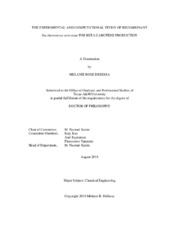| dc.description.abstract | Terpenes are an important and diverse group of chemicals used in many industries, including nutraceuticals, pharmaceuticals, alternative fuels, and personal care products. In yeast, the natural mevalonate pathway provides a starting point for genetically engineering terpene-producing strains. One such example of the advantageous exploitation of the mevalonate pathway is the work done in the Kao lab with Saccharomyces cerevisiae. A strain of S. cerevisiae, named SM14, was engineered to produce beta-carotene. Beta-carotene is a carotenoid that is used as an orange food dye, in supplements due to its antioxidant properties, and in vitamins as a precursor to vitamin A. This document describes the further study of strain SM14, both experimentally and computationally, to understand and improve the production of beta-carotene. SM14 was cultivated in a bench-scale bioreactor and key metabolites and off gas were analyzed. In addition, this experimental data was further studied using a flux balance analysis program in Matlab® (Mathworks®) known as Constraint-Based Reconstruction and Analysis (COBRA). This program allowed the intracellular behavior of SM14 to be extensively studied. The dynamic behavior of the strain was also examined using the COBRA strategy in combination with other optimization strategies. The intracellular behavior of the continuous production of beta-carotene was also studied using COBRA models in conjunction with a continuous kinetic model. Further utilizing these computational techniques, the Optknock tool within the COBRA toolbox was used to target beneficial gene knockouts. The CRISPR-Cas9 system was examined as a method of efficiently performing these knockouts as well as more traditional knockout methods. The results of these experiments are discussed. | en |


